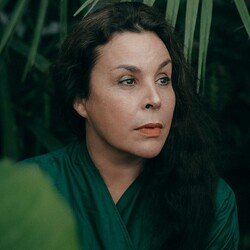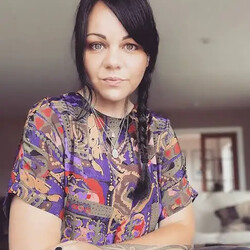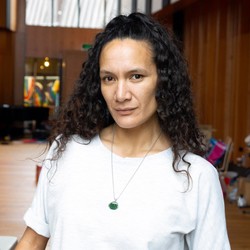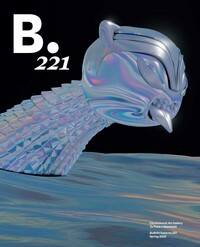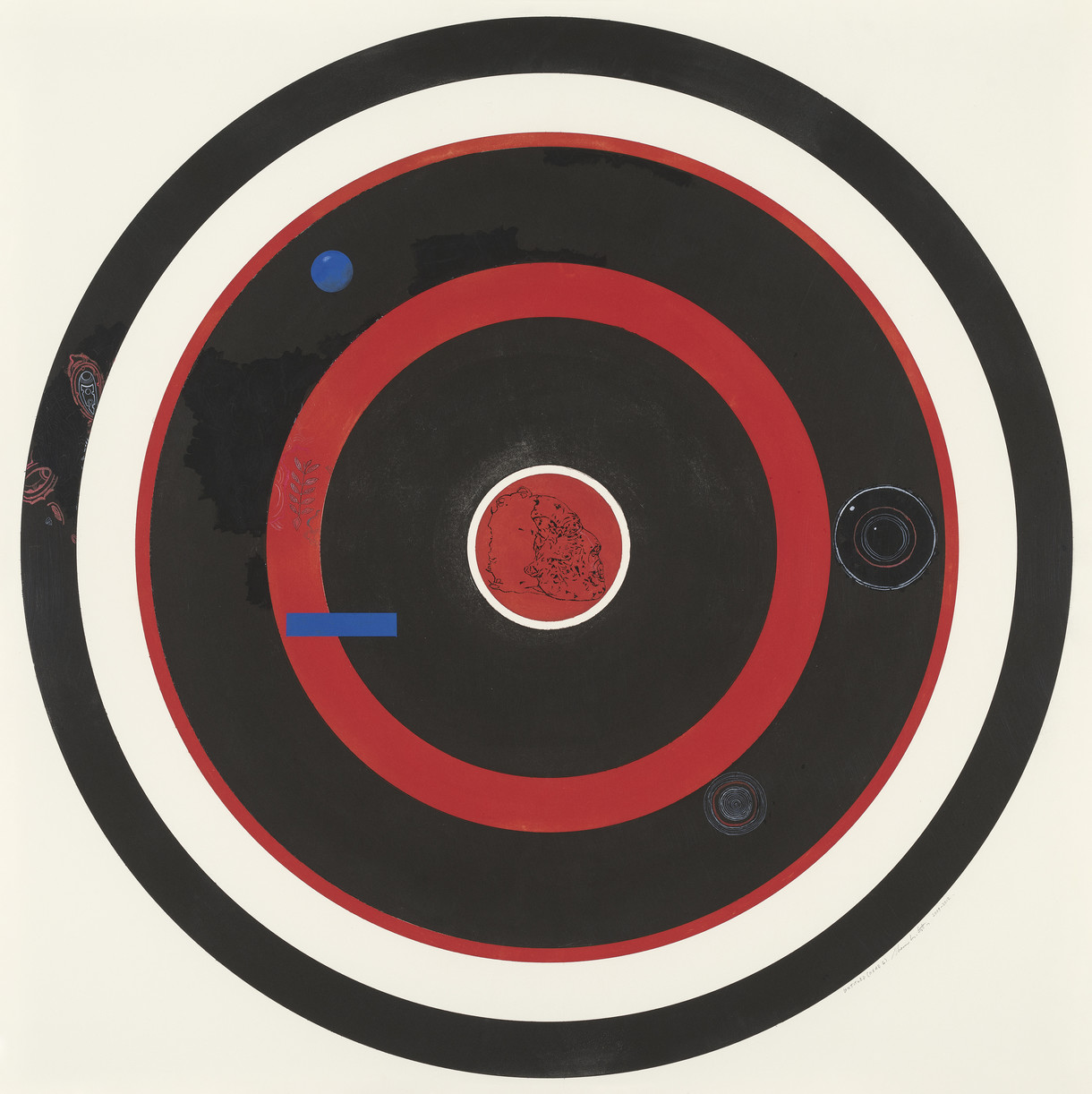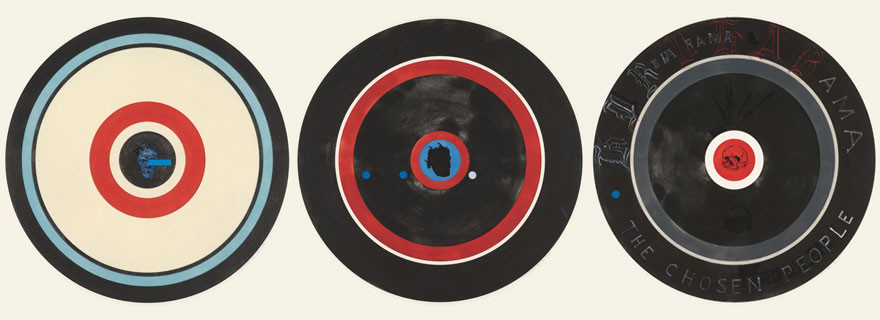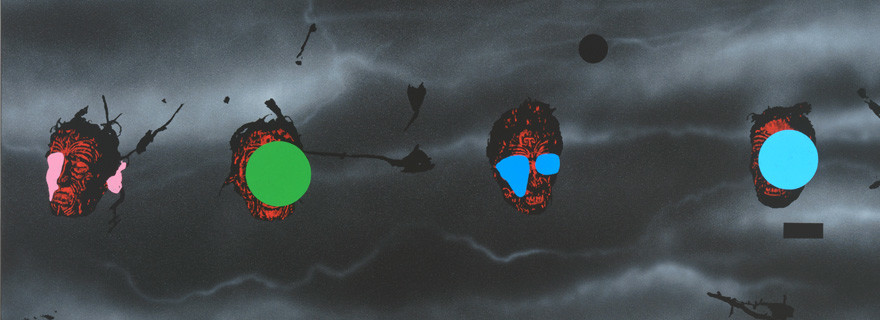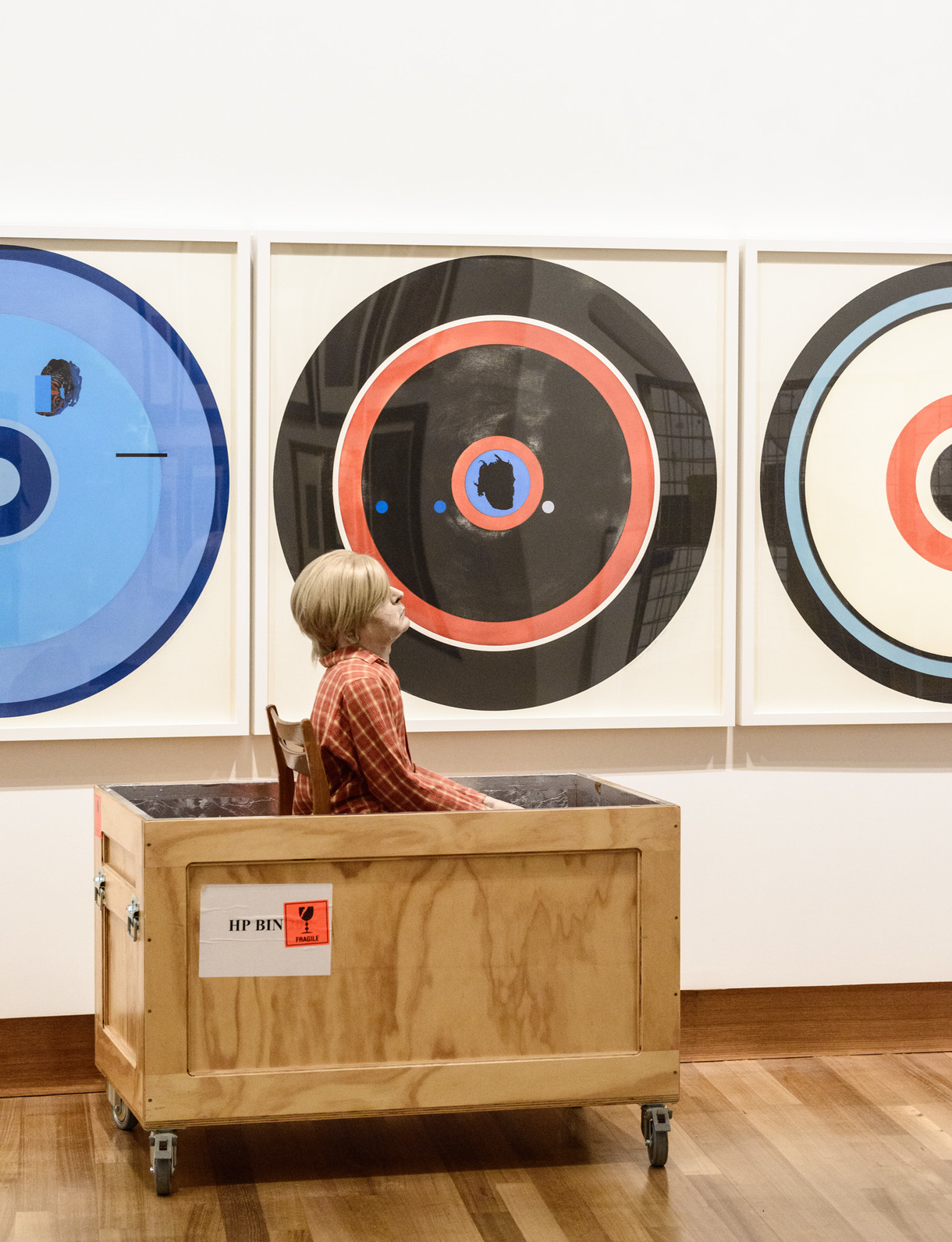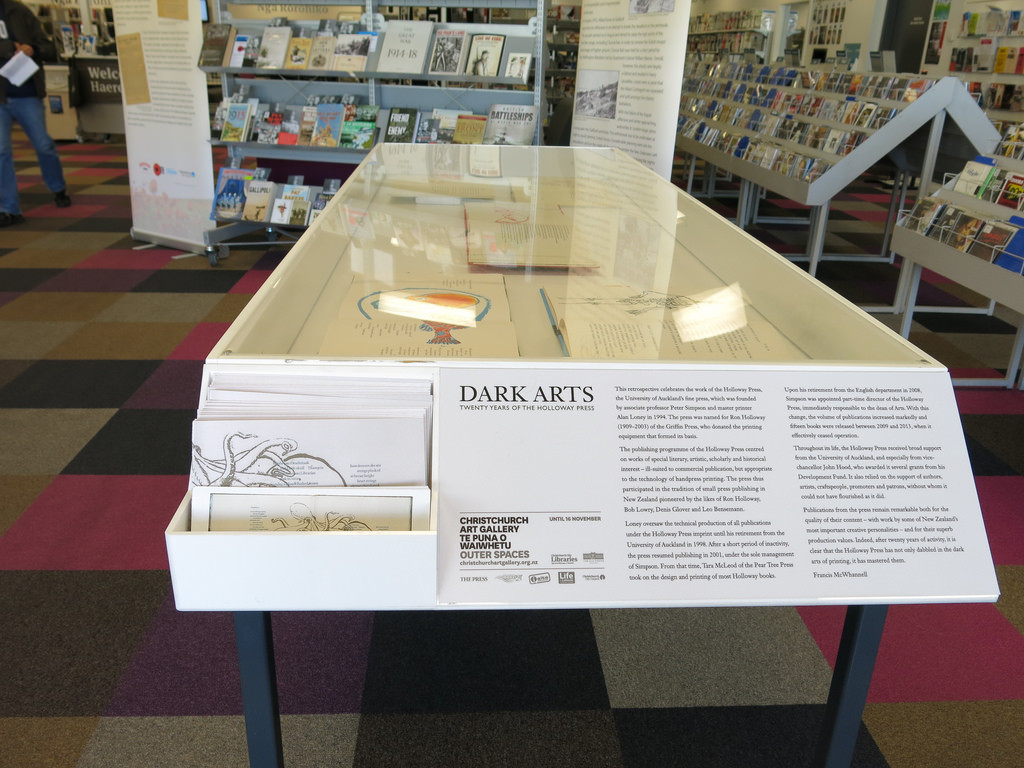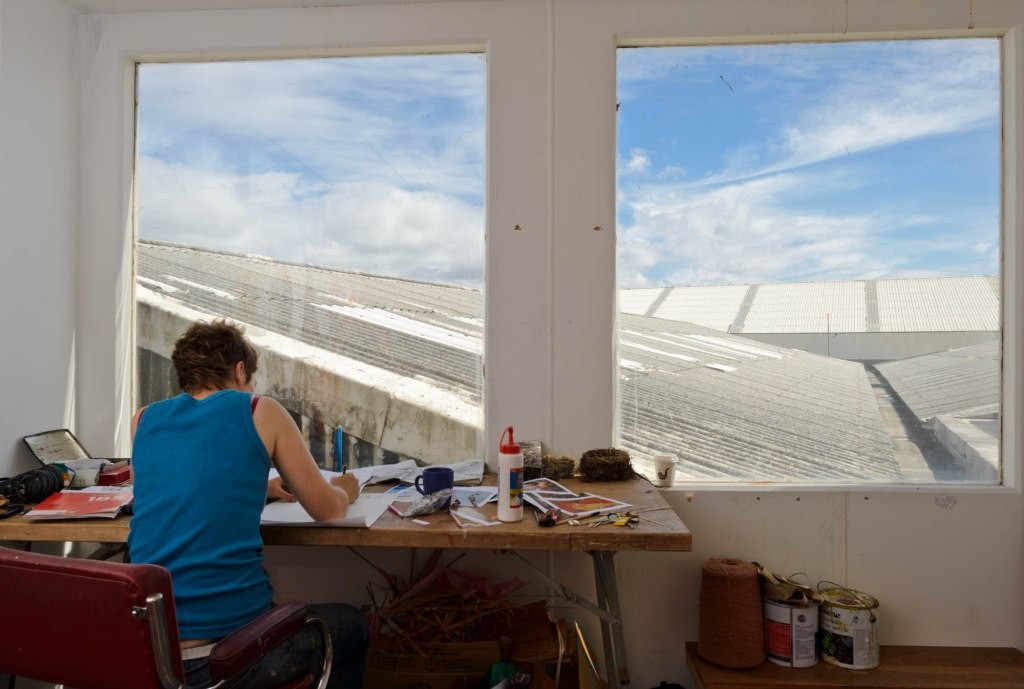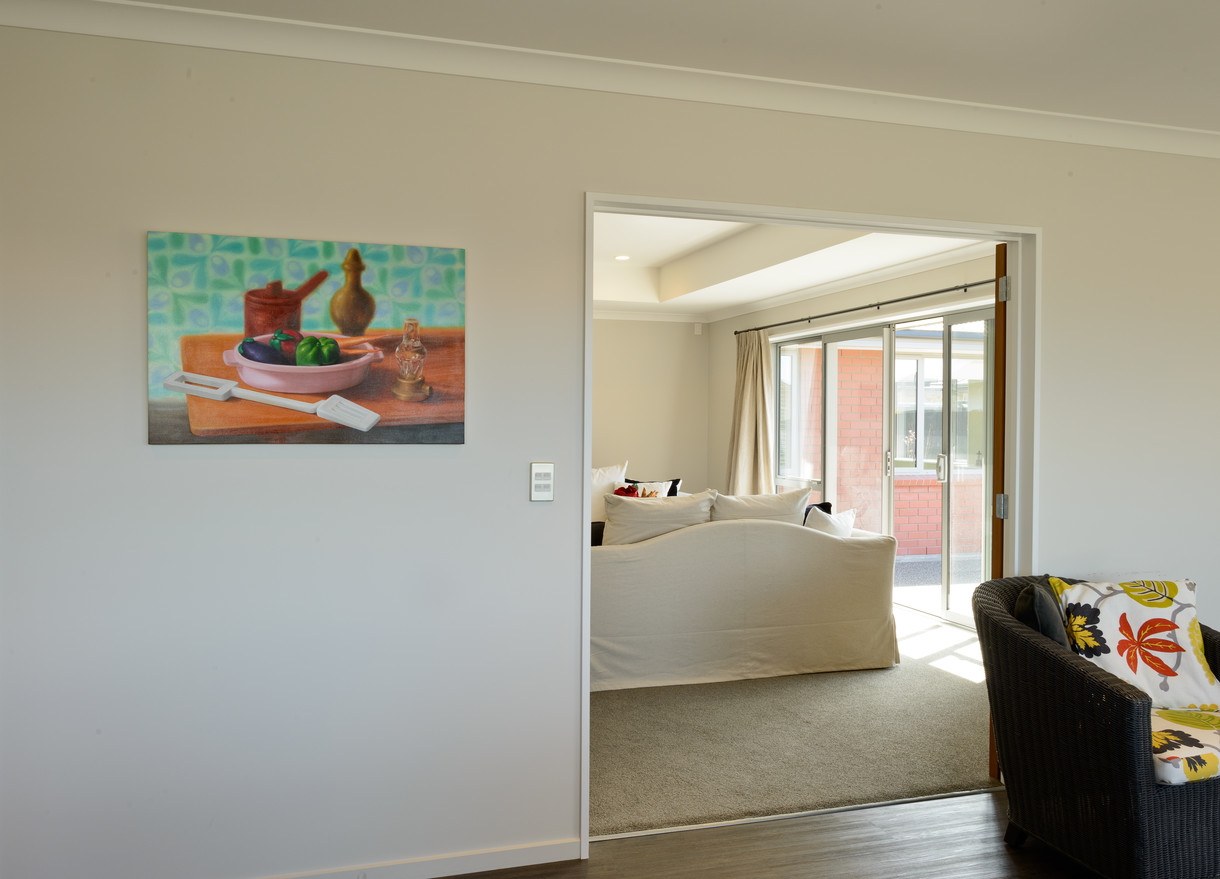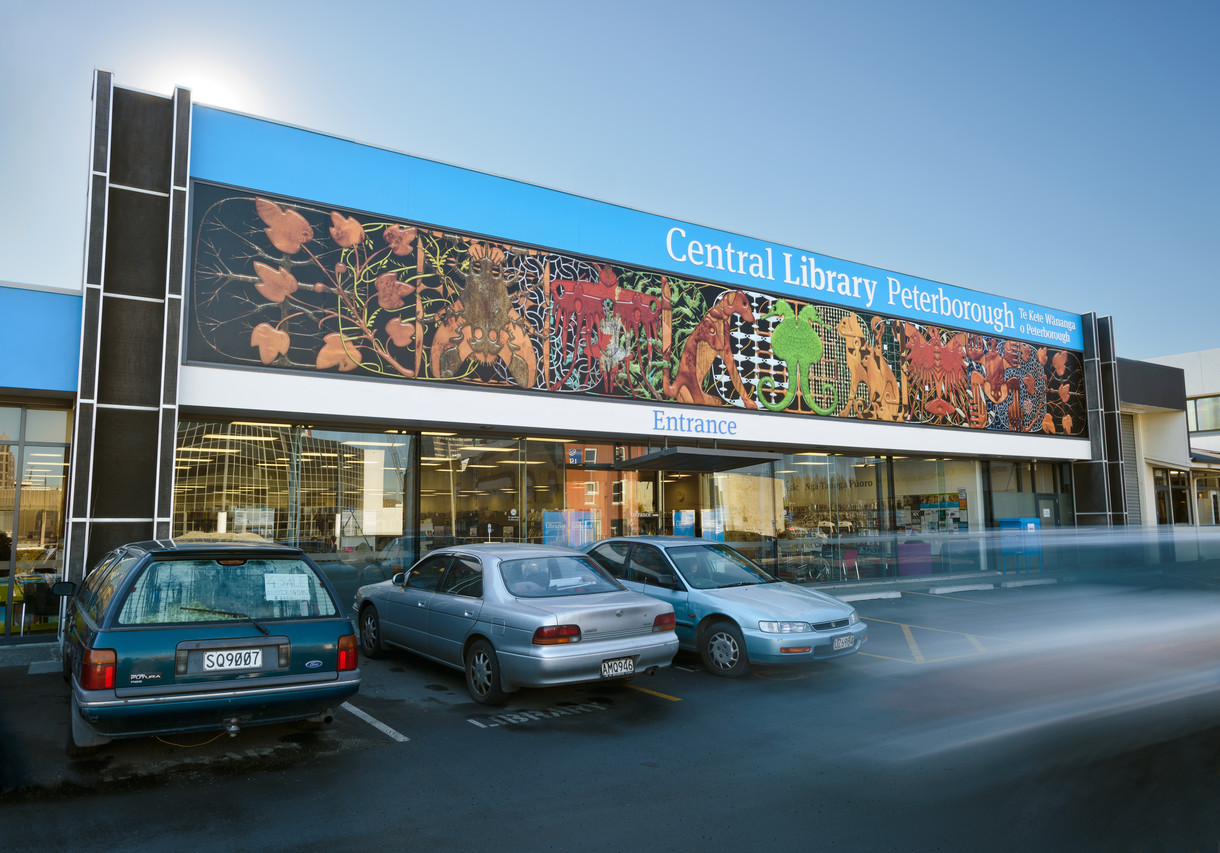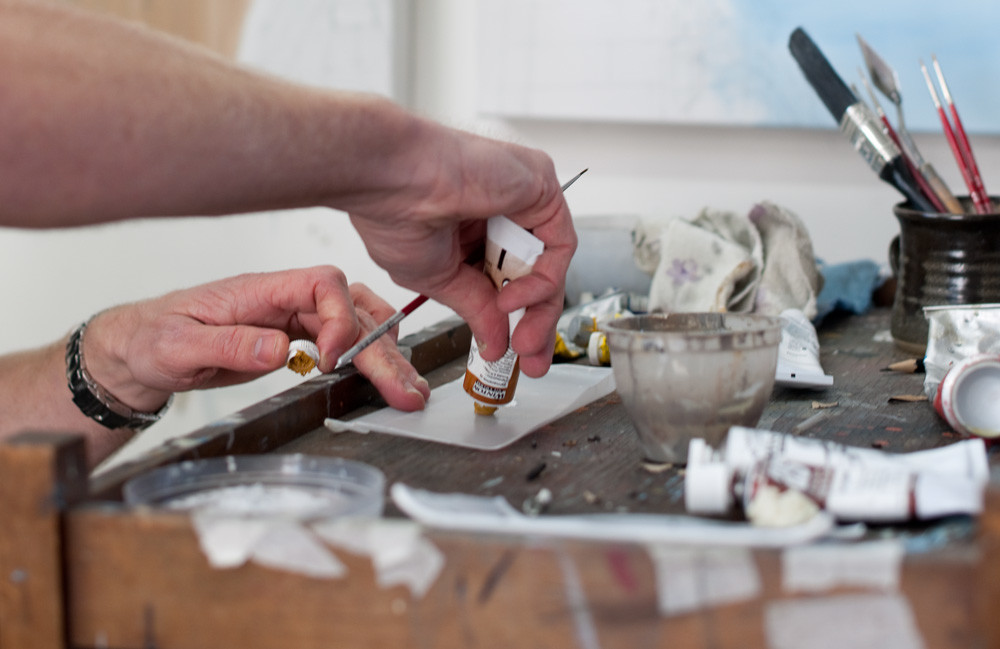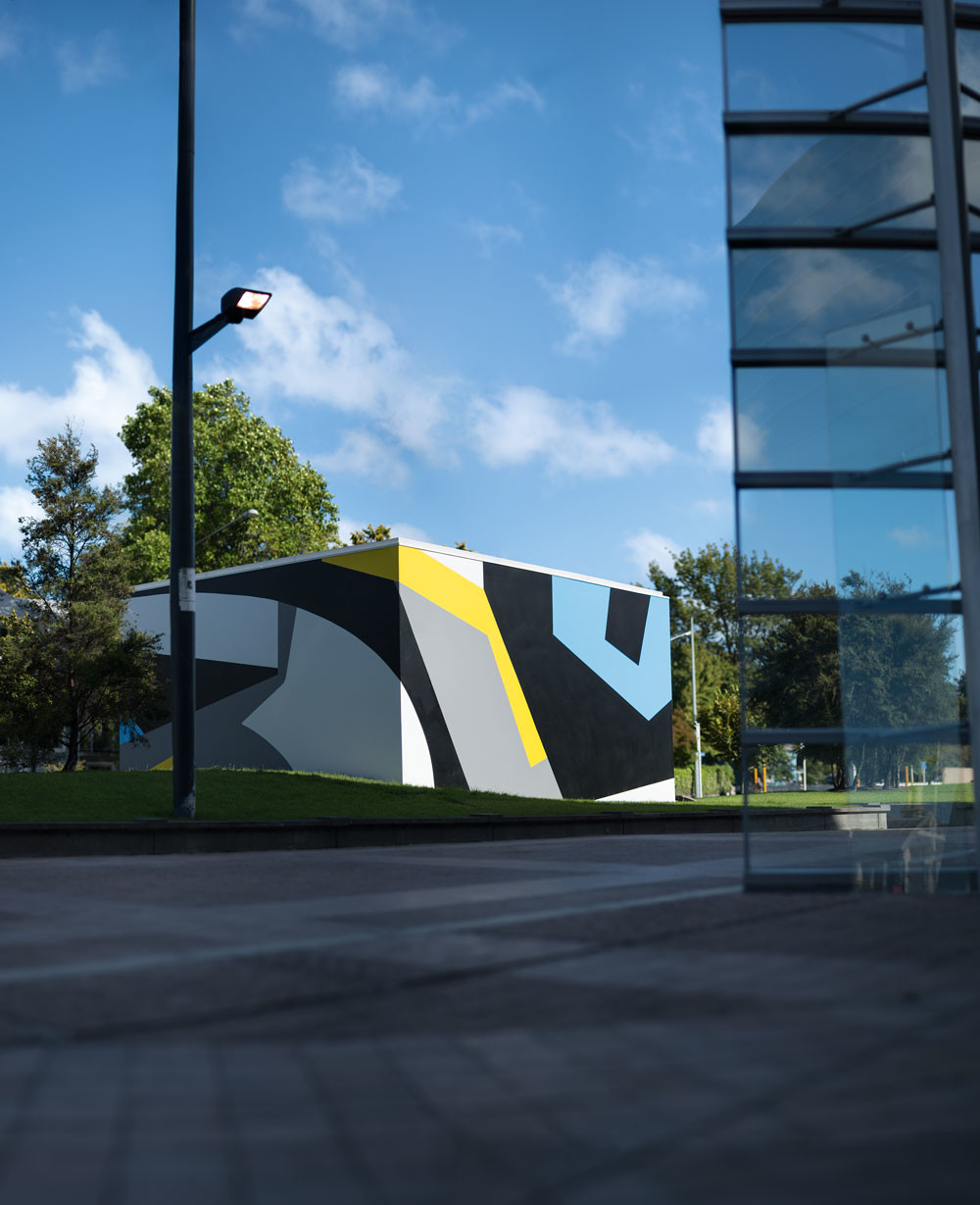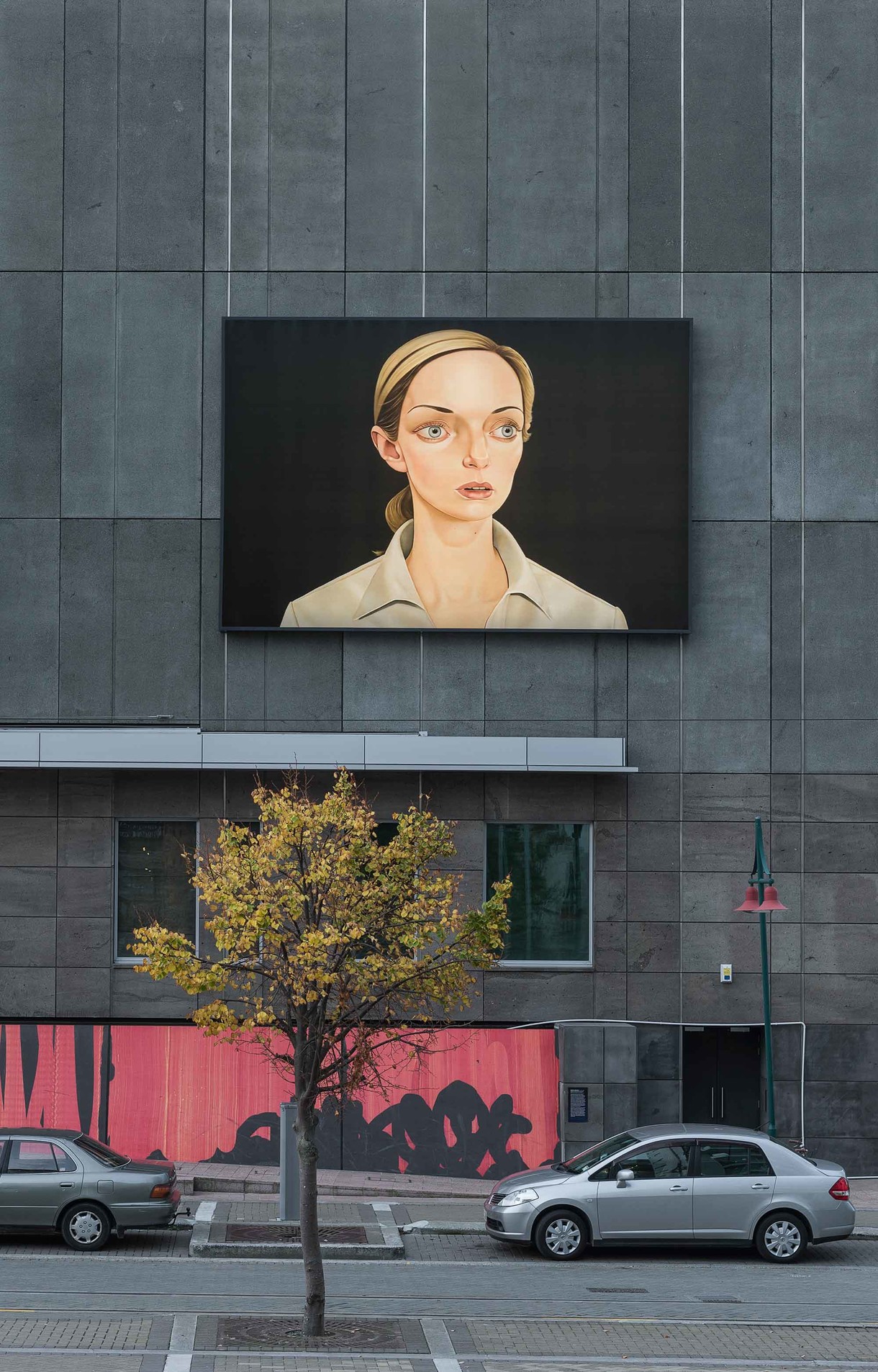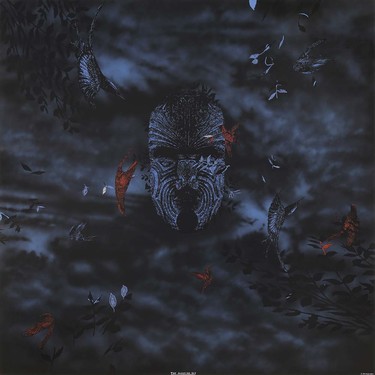
Shane Cotton The Hanging Sky 2007. Acrylic on linen. Collection of Peggy Scott and David Teplitzkythat
Shane Cotton
Stamina, Surprise and Suspense
Back on 20 September 2011, when our public programmes team began setting up the Hagley Park Geo Dome for a talk with Shane Cotton, they put out about sixty chairs and would have been glad to fill them. After all, it was a cold night in Christchurch, the roads were rough, the Geo Dome was off the beaten track and the quake had long since broken the rhythm of the Gallery's old Wednesday night programme of public talks.
As it happened, several hundred more seats were called for, as people kept flooding in for what turned out to be one of the biggest public programme attendances on record at Christchurch Art Gallery – around four hundred people. You could put the turnout down to a dearth of cultural options in the post-quake city. But the real reason, surely, was the powerful sense of connection and interest inspired by the paintings of Shane Cotton, who trained at the University of Canterbury School of Fine Arts and is now one of Australasia's most esteemed contemporary painters.
Well before the quake, senior curator Justin Paton was working with Cotton on a show that combined some brand-new paintings with a selection of skyscapes from the last half-decade – many of which have not been seen in New Zealand. Several years and many aftershocks later, that show, titled The Hanging Sky, is about to open in Brisbane at the Institute of Modern Art, then to travel to Campbelltown Arts Centre in Sydney, before returning to New Zealand and (cross all your fingers, please) the newly reopened Christchurch Art Gallery – where we hope to connect again with all the people who braved the cold for Shane's talk back in 2011.
Here's some of what they heard that night.
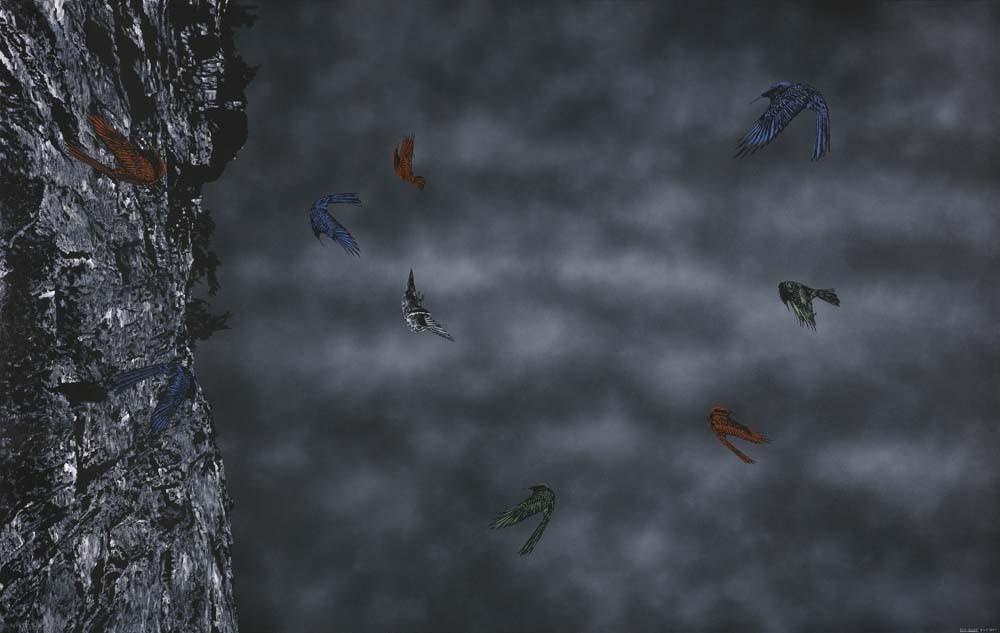
Shane Cotton Red Shift 2006–7. Acrylic on linen. Collection of Queensland Art Gallery. Purchased 2007. The Queensland Government's Gallery of Modern Art Acquisitions
Fund (acc. 2007.183)
JUSTIN PATON: I want to start by singling out three qualities that I think characterise Shane's art and give us good reasons to look at it and think about it and care about it. And those are stamina, surprise and suspense. Stamina, because Shane's been producing powerhouse work across more than two decades now. Surprise, because at key moments throughout those decades, often just when a consensus had settled about the content of his work or where it was going, Shane put his head down, changed up a gear and turned his painting and his art in an unexpected direction. And suspense, because his paintings so often seem to put us on the threshold of an event or transformation – something about which we feel both uncertain and intensely curious. With luck the conversation tonight will be a chance to press a bit closer to some of those transformations.
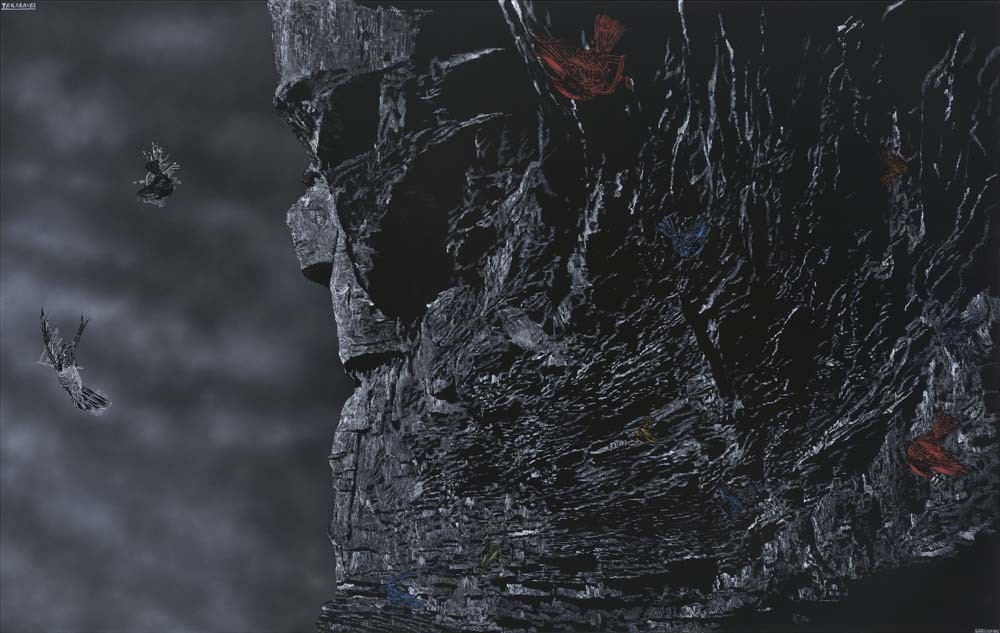
Shane Cotton Takarangi 2007. Acrylic on linen. Collection of Christchurch Art Gallery Te Puna o Waiwhetū, purchased 2007
Shane, the earliest work in the exhibition we're planning is from around 2006, but I thought we'd jump back to a work called Lying in the Black Land. It's from 1998 and in some ways feels like it's from another time. The nineties was a period when a lot happened for you, so how does it feel to look back on this moment?
SHANE COTTON: It's always a wee bit scary looking back at old work. I went to art school here in Christchurch, and when I came down from the North Island I didn't know a hell of a lot about painting. I went in with a view of just wanting to learn – to learn about the process and the history of painting. I didn't have any inner demons or internal conflicts I was fighting within myself, I just wanted to immerse myself in the whole practice of painting – what it was to be a painter, what it was to make images, what it was to try and invest power in an image. So when I left art school the world was my oyster, and I started doing very organic, very painterly work. I was throwing lots of information and visual material in just so I could keep up the thing I was doing at art school, which was finding out what it was to make a painting.
Then I shifted to Palmerston North and I took up a lectureship in the Māori Studies department and all of a sudden I was exposed to a different kind of history, a Māori colonial history – it was something that I didn't know about in any great depth but I had to try to teach the stuff. I was learning, teaching, learning, teaching, all at speed, and it started feeding into my painting.
So a lot of the work through the nineties was dense; it was dense with biblical scripture and dense with Māori history, which was new to me. I wasn't so much trying to teach people about this stuff as trying to understand it for myself. And because I was interested in the painting process, and because I had become interested in New Zealand history and the way that it was momentous and caused huge shifts and changes for both the Pākehā and Māori, I just couldn't get away from it.
I suppose in many ways I made the mistake, as a painter, of not knowing when to stop. I was trying to fit all this stuff in and then somehow get it out and expose it. I wanted to see what the audience was going to make of it – what they had to say about it, if they would learn something new from it. It was one of those times in a painter's career where certain things come together – you have your moment and the culture around the work supports it. The polemic, the dialogue, the postcolonial argument, everything was about those kinds of debates. We were coming hard off the Headlands [Thinking through New Zealand Art, 1992] show and the whole conversation about cultural appropriation and what it means for a white person to use a Māori image, what a 'Māori image' means, what it means for a Māori person to be influenced by contemporary art forms from around the world – is it still Māori art? All these questions were being posed and I was like a sponge, absorbing it and feeding off it and working out some kind of reaction to it.
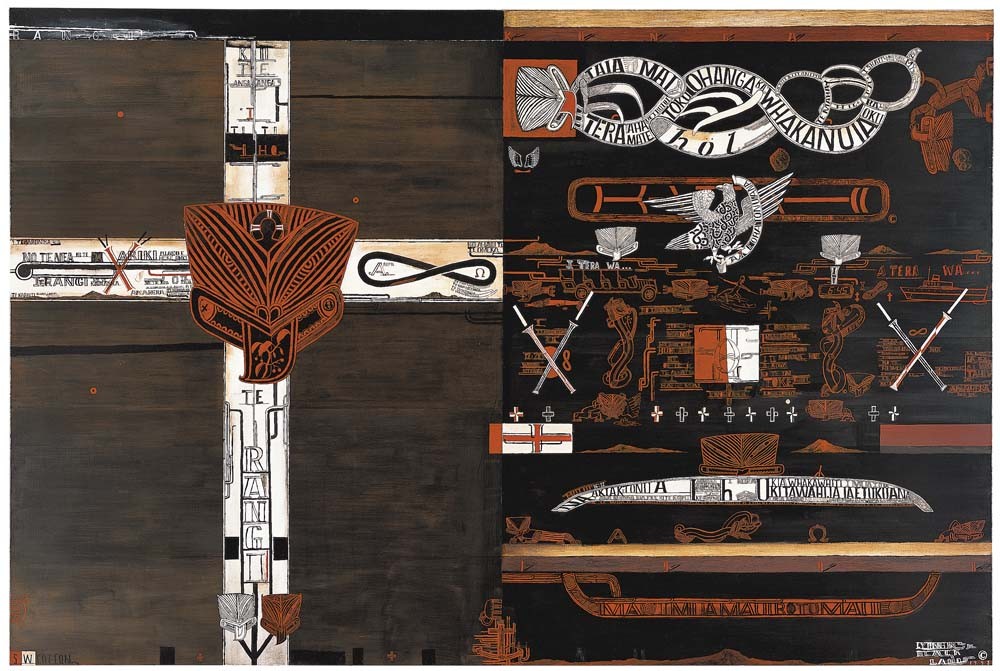
Shane Cotton Lying in the Black Land 1998. Oil on canvas. Private collection, Auckland
But by the time I got to Lying in the Black Land I'd gotten through a lot of that. And as a painter, once you know how to do something there's no point going back to do the same thing. What's the point? You know how to do it, you know the result you're going to get, you want to try something different. One of the painters I admire is the American Agnes Martin, who has devoted her career to making very subtle, very refined, abstract paintings. I love the way some painters have this ability to sustain one kind of style or obsession or interest in work over a period of, say, six decades. I find that incredible, but it's not what I can do. I'm a bit of a magpie, flying around pinching stuff. I want to experience what it's like to make different kinds of images, so I don't have any problem with how different a new painting might look or how it sits against earlier work — that's the curators' job. They're the ones who say it's right or wrong or he's gone bloody haywire. I don't worry too much about it. If you worry about those sorts of things, you're going to get long periods of procrastination and painter's block. Just put it out there and see how it's received...
JP: So between the 1990s and a work like Red Shift in 2007, what happened? You had been carrying so much cultural baggage and in Red Shift it's all been jettisoned. You've taken off, you're flying. Why did that happen?
SC: I wanted it to be minimal. I was trying to make an image in a very economical way. And I was trying to present something that had a sense of purpose about it. But I didn't want to labour over it. Another painter I really admire is Ed Ruscha, and if you look at a Ruscha canvas it's the concept you register first and the practice thing comes after. I really admire the gravity of those works, yet if you look at the surface, it's a bit of a letdown – very, very light on the canvas. It's almost as though if he doesn't get it right in the first stroke, he doesn't labour over it; he just puts it aside and tries again. I like the fluidity and the ease with which he makes that heavy statement, the contrast between lightness and weight. And because I was working with acrylic after using oils for a long time, I was experimenting with that kind of feel in the work and how it was actually made.
JP: One thing that really stands out in the paintings of the mid 2000s is your constant engagement, one might even say your obsession, with the colour blue. What led you to that?
SC: I was thinking about this the other night, wondering why the hell did I start painting blue? I just couldn't remember. It was my wife who reminded me that it was because of the word 'kikorangi'. I sometimes use biblical scripture in my work and I referenced Genesis – that moment, that Christian moment, of the beginning of humanity, where life on earth as we know it unfolds. In the Māori translation the word for firmament is kikorangi, which I think is a really interesting word. Kikorangi is the colour blue. But it's made up of two words – 'kiko' is flesh and 'rangi' is sky and I've always wondered why that relationship is used to describe the colour of the sky. I think, and I'm guessing, that it's something to do with the use of moko, because when you place moko under the skin it turns a particular blue. But anyway, because of my interest in that translation I started painting everything blue. It became like an anchor for me, a way to reference that moment or schematic shift as one story is translated into another. I was also going back to the economy thing – trying to limit the way I was making the paintings, limiting my palette...
JP: Speaking of blueness and tattooing, can we look at the painting from which the show takes its title, The Hanging Sky. Can you tell us about this particular face – where it's from, why it's played such a part in your art, and how you've transformed it?
SC: This is based on Hongi Hika's carved self-portrait bust that he did when he was in Sydney. It's a very intricate carving and I started painting it because, one, I was interested in the pattern itself, the beauty and the symmetry. The presentation of the photograph that this is based on is frontal, so it meets you straight on, and you can see the pattern perfectly.
He's a Ngā Puhi leader so that's obviously important to me because of Ngā Puhi narrative, but for me this image really matters because it symbolises a moment of change. He lived in a time where he saw Māori custom change into the world of colonial New Zealand. He saw momentous change and shifting in society and so to me he's symbolic of that idea of transformation, be it cultural transformation or identity transformation or whatever. I started painting him in lots of situations where he's not static – where he's fluid and things are happening in and around him. It's this idea that everything's in play and nothing stays the same.
JP: And what about the many heads that float in Tradition, History and Incidents?
SC: Most of the heads I use come out of the Major-General Horatio Robley collection of mokomōkai that he assembled in the late nineteenth, early twentieth century. I've done a few from photographs of heads in collections but mostly the heads that I've used have had some kind of connection to Robley and I think that's because there is a very famous picture of him sitting in front of his collection. It's a really odd picture, but my position is that in a way what he did was good because it kept a kind of record. But you know, when I remade this image I didn't take a position on it. I was interested in the image and the way it was captured and I just wanted to re-present it – to re-present the heads in a surreal unknown state and remove them from that original position.
JP: And beyond the faces, how about the spaces they hover in – the deep, dark skies that start to open up around 2006? The earlier works, Lying in the Black Land among them, tend to put us in quite a stable position as viewers. We feel a bit like surveyors looking out towards a steady horizon, or museum visitors looking into a cabinet. What were you after, with the new and much more open spaces?
SC: You know if you see a bird flying through a landscape you sort of see its motion; you don't actually stop it at all. But in the new paintings the birds were suspended in space and it was like the rocks were starting to move – that's how I was starting to see it. It happens in Takarangi, this reversal of things, and I became interested in the way that elements were swapping places. The birds were stopped and it was the mountains that were moving or, in terms of the way the marks were flowing, had the potential to move.
JP: So to ask a probably unanswerable question, where are we in these works? What is this space for you?
SC: I wouldn't say it's a dreamscape necessarily, it's more of a surreal space. If I think about surrealist art generally, it's about the uncanny – it has this familiarity about it, but it's presented in such a way that something strange is also occurring. I think these works are a bit like that. My family comes from the north and we're very superstitious people, and I like this idea of superstition in my work – it's not something that I talk about a lot but I think there's something in my work that alludes to that, this sort of uncanny unknown, where you become very wary or very suspicious. For me that's what it's about. In Takarangi the space is a naturalistic space in a sense – it's a real-time space – but then in behind the birds are those very light graphic lines. They're like little manaia figures, little sort of doodles, but they frustrate the space a bit. And I sometimes do things like that because I want to remind the viewer that it ain't all that real. That it's a space that potentially is not of the real world – not of the natural world. That it's constructed, that it's personalised in some way.
JP: I'll hit you with the big question. Someone might say, 'I'd like to explore all this through a photograph'; someone else might say, 'I'd like to explore it through film'. Why are you a painter and not another kind of artist? What is it that painting does for you, or lets you do, that you couldn't do in those other media?
SC: I just like the process of painting. I like remaking images in paint. If I'm trying to develop a work, it often comes from seeing an image. I might see an image of a cliffscape and use that as a starting point. And quite often, when you're covering large areas with singular marks, and you're trying to build up this density to give the impression of the cliff, it becomes like a Chuck Close painting. You look at a Chuck Close painting and he's got this grid system – he only ever considers one point on the canvas at a time before moving to the next point and then he stands back and takes in the enormity of the whole process that actually makes the image. That's how I work sometimes, and I don't know of any other art form that allows you to do that.
You could probably do it with a computer but then you'd miss the physicality of it, the physicality of dipping the brush into the goo and trying to see how far it goes before it runs out, so you reload the brush and you're constantly adjusting. That's the process of painting and that's the thing I still enjoy doing. Sometimes when you're working on big canvases you go into a studio and you've got all the energy in the world so you start down in the corner, and a few hours later you find yourself thinking this ain't gonna work... But I like hanging in there and grafting it and working it out. And as I start to get into the process and the density starts to build, it opens up a whole lot of other ways you can get into it – will you take to it with a spray-can? What does the thing as a whole tell you about where you are going to place an image? You're working it out as you go, sniffing around to see if it's going to work, and sometimes it doesn't. I like it when you get to the point of beginning to admire it, and then the next day you go in and you get the spray-gun out and you start wrecking it a bit. That takes the painting somewhere else and you try and deal with that and get through the problem you've created for yourself.
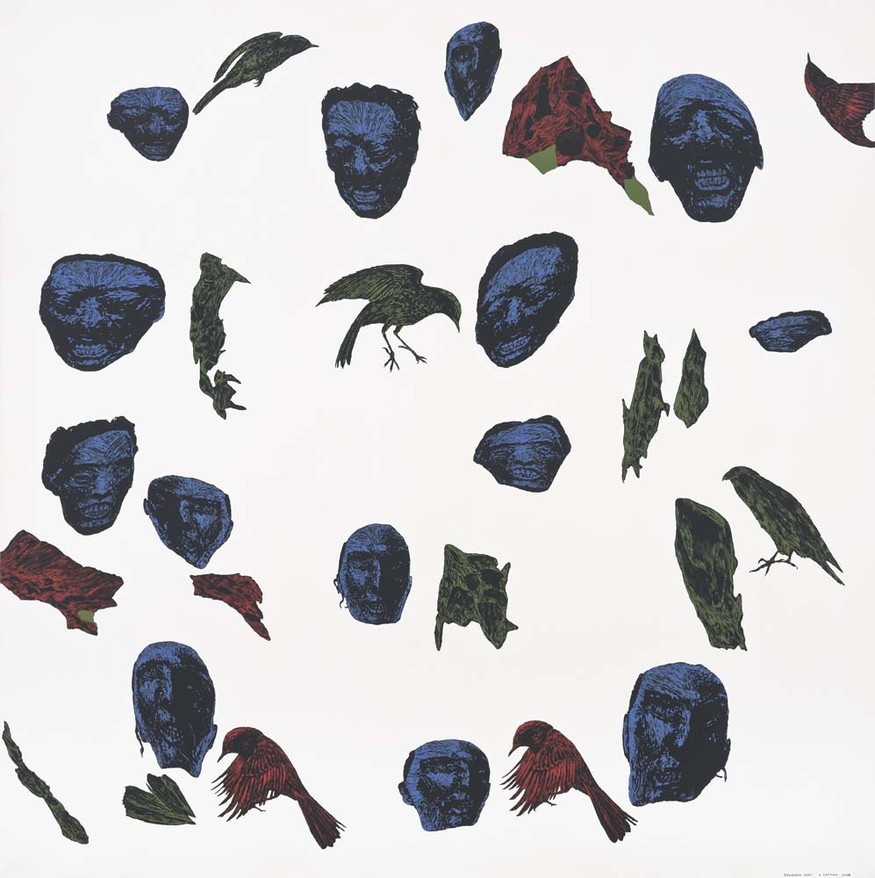
Shane Cotton Coloured Dirt 2008. Acrylic on linen. Cotton collection, Palmerston North
JP: With you living in Palmerston North I'm not in your studio very often at all, so I've got to admit the last few visits have been almost shocking... [SC: Thanks, mate.] There was one occasion in particular where you'd painted a beautiful sequence of skyscapes—they were lyrical, they were eerie, and I thought, 'That looks fantastic.' And when I came back again you'd vandalised them with red spray-painted words. Do you have strategies you use to keep yourself on your toes in this way, to deliver these sorts of small shocks to your viewers?
SC: A strategy? No, I just kind of go with the flow. You get to a point in your work, I think, when you know how to do something and it doesn't fill your creative cup any more. So one of the things I started doing was wrecking my own work a bit. I wanted to jar it.
If you go back to a work like Coloured Dirt you see that I wanted it to be well crafted, I wanted it to look super-natural—to be captured like a photograph. I love the way a painting can be a vehicle for tricking the viewer; I'm still fascinated by paintings like that myself. But when you know how to do that, you get tired of it, so I started doing these other things with graffiti—I wanted to disrupt the perfect environment or world that I was painting. After airbrushing in some skyscapes, one day I just started writing text all over, really getting into it. It was a fine line between 'Is this thing getting better?' or 'Is it getting worse?' and for quite a while it wasn't getting good at all. But as you come to understand the painting conceptually you make it right; I felt comfortable with the way the paintings were disrupting themselves and so I started showing them.
JP: On the one hand you seem to hold out the lure of something to read, but, on the other, this red skywriting is very hard to read. It's often in another language, a language many viewers won't understand. There are layers; the words fade out raggedly. Why is it important to make it hard for us to read?
SC: If you look at a McCahon, his use of text was very much about the idea of reading a painting—he wanted you to read it. I don't. The text in my work is more like an interference pattern. There may be keywords—for instance, the text in many of those works is from the Book of Job; it's at the beginning and God and Satan have a conversation, they have a wager. Satan says, 'You know, I reckon if you give this guy a hard time he's going to come over to the dark side.' But before that God says to Satan, 'Where have you been?' And there's this lovely series of sentences where he describes how he's been drifting through earth, walking through the earth and walking through the sky, toing and froing in the earth. If you consider how, as a Māori person, you might think about the land, you quite often tend to personify it through its name. And if you think that something bad is wandering though you, it's somehow affecting you. I've always thought that kind of creepy. I'm interested in that piece of text so I painted it in English and then I painted another one, which is the Māori translation. I've given them the same treatment – I use words like an image. I want them to operate like the birds or the clouds but at moments you can make out a word – you might make out the words 'Satan' and 'earth'. You might see the words coming to you, from you, through you. I'm alluding to the possibilities of something else instead of demanding a literal reading
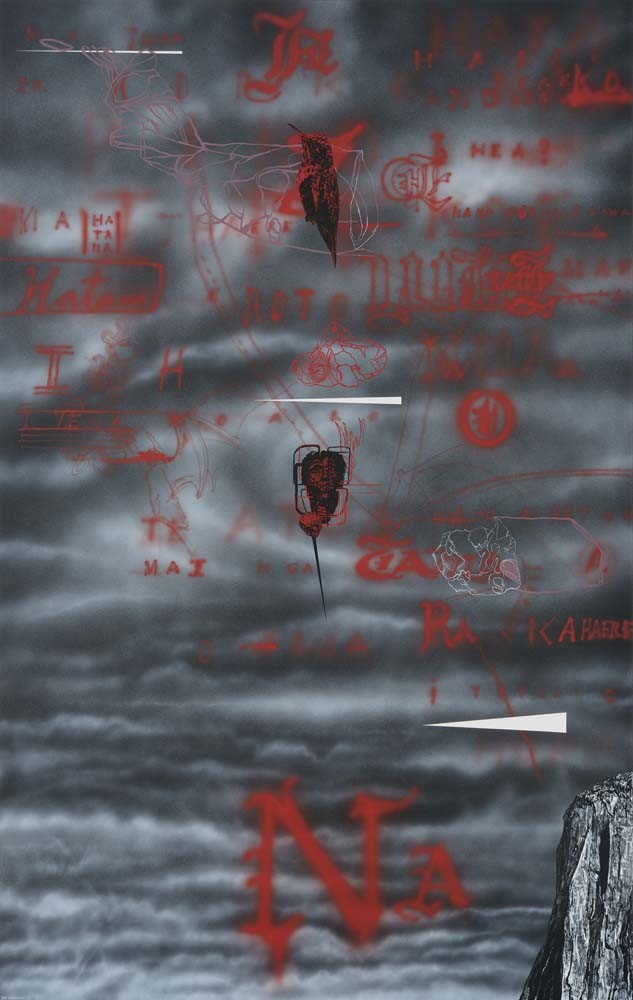
Shane Cotton Na 2010. Acrylic on linen. Courtesy the artist, Anna Schwartz Gallery
Shane Cotton: The Hanging Sky is on display at the Institute of Modern Art, Brisbane, from 8 December 2012 until 2 March 2013. Organised and toured by Christchurch Art Gallery Te Puna o Waiwhetū in association with the Institute of Modern Art, Brisbane.
